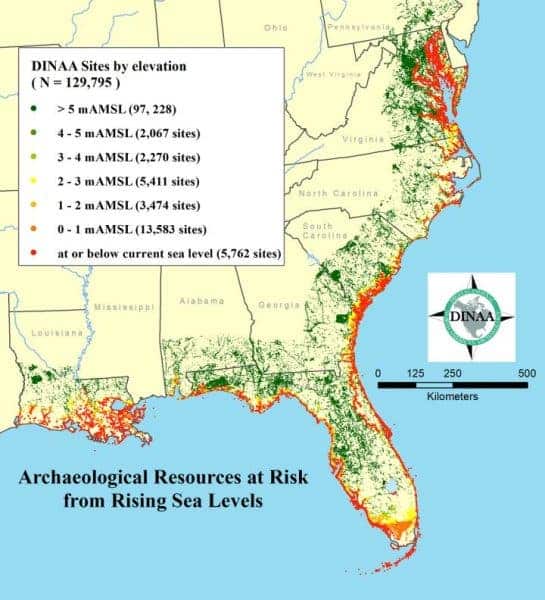Thousands of historic and archeological sites along the southern US coast risk being engulfed by sea-level rise by the end of the century, scientists report.
Climate change isn’t putting just our future at risk — it’s also engendering out past, according to new research. More than 13,000 archaeological sites, historic buildings, and cultural landscapes on the Atlantic and Gulf coasts of the southeastern United States are at risk from sea-level rise and could be submerged by 2100.
No ark for this flood
The team, led by David Anderson from the University of Tennessee, Knoxville drew on data from the Digital Index of North American Archaeology (DINAA) to estimate the risk posed by sea-level rise on archaeological sites. DINAA is a platform that aggregates archeological and historical datasets compiled over the past century and from numerous sources. Its aim is to provide researchers and the public with a comprehensive view of when and where humans settled.
Based on position and elevation data, the team warns that over 13,000 sites in the southeast alone may find themselves topped with water for a mere 1 meter (3.28 ft) rise. This includes over 1,000 sites listed on the National Register of Historic Places as having important cultural properties. But things could get much, much worse.
“These numbers increase substantially with each additional 1 m rise in sea level, with >32,000 archaeological sites and >2400 NRHP properties lost should a 5 m rise occur,” the authors warn.
“Many more unrecorded archaeological and historic sites will also be lost as large areas of the landscape are flooded. The displacement of millions of people due to rising seas will cause additional impacts where these populations resettle.”
Large linked data sets such as the DINAA, which can predict the potential impacts of phenomena across wide areas, are essential when developing procedures for sampling, triage, and mitigation efforts, the team explains. Therefore, they hold the key to planning and adaptation in the face of climate change, extreme weather events, and the displaced populations these will bring about — factors that could shape our civilization profoundly in the years to come.
“Sea level rise will thus result in the loss of much of the record of human habitation of the coastal margin in the Southeast,” the paper reads, “and the numbers indicate the magnitude of the impact on the archaeological record globally.”
The paper “Sea-level rise and archaeological site destruction: An example from the southeastern United States using DINAA (Digital Index of North American Archaeology)” has been published in the journal PLOS ONE.










